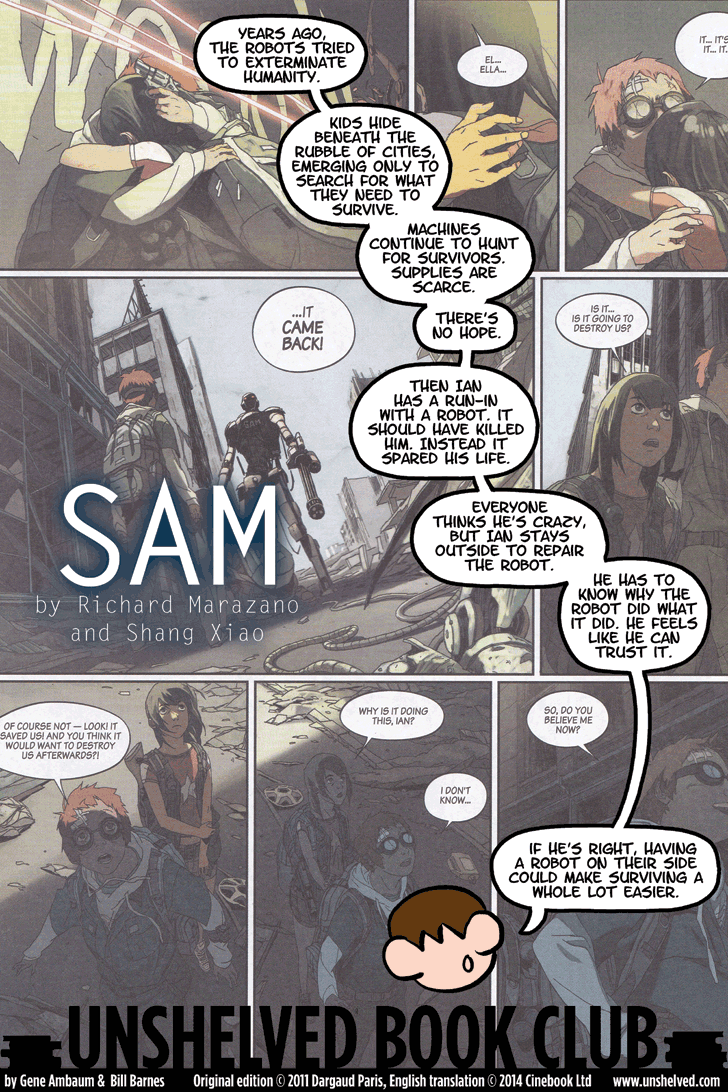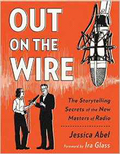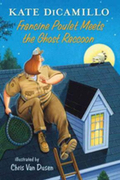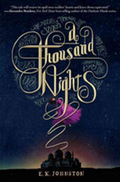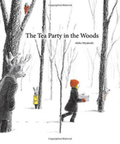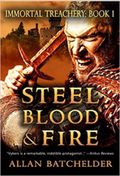Link to this review in the form of a comic strip by geneambaum tagged science fiction • graphic novel • coming of age
Link to this review by sarahhunt tagged graphic novel • biography
Steve Jobs was a tinkerer, spiritual seeker, believer in simplicity, an annoying boss, a risk-taker, and had impossibly high standards. His own interests and obsessions became part of our daily lives via Apple’s incredibly popular and accessible technology.
Why I picked it up: I wanted to read about his life without having to wade through a 630 page biography. (This one is only 223 pages.)
Why I finished it: Many biographies, especially for young readers, attribute the eventual success of their subjects to significant events from their early lives. Hartland includes a lot of normal stuff, good and bad, that didn’t necessarily contribute to Jobs’s amazing influence: how he got bored with family life and left his daughter with his girlfriend, his decision to buy hundreds of identical black turtlenecks, debating the pros and cons of different models of washing machine. She draws stink lines around him after he decides he doesn’t have to bathe as often as others because he is a vegetarian. She doesn’t leave out Jobs’s drug use, his dropping out of school, or his foray into phone phreaking. She creates a rounded portrait of Jobs instead of a sermon for kids on how to work hard and become famous.
Readalikes: Before Jobs was an idol, the kids in my advanced placement class devoured books about physicist Richard Feynman, especially Surely You’re Joking, Mr. Feynman! and What Do You Care What Other People Think?. Jim Ottaviani wrote an excellent graphic novel biography, Feynman, which captures both his genius and his difficult side.
Link to this review by geneambaum tagged graphic novel • nonfiction
Graphic novelist Jessica Abel interviewed producers and creators of Planet Money, Radiolab, the Transom Story Workshop, The Moth, 99% Invisible, and Radio Diaries to find out how they produce compelling, transcendent narrative journalism on NPR. An amazing amount of work goes into each story, from trying to figure out what the story is to editing/assembling to brutal group edits. (Snap’s Glen Washington says everyone needs to “Take out the knives and hit [the story].”)
If you’re a fan of Abel’s work or This American Life this may sound familiar. Years ago she created Radio: An Illustrated Guide to investigate Ira Glass’s system for producing TAL radio stories. Twenty-four pages of that guide are excerpted in this book.
Why I picked it up: I’m a fan of Abel’s work (La Perdida, Mastering Comics), and I listen to all of the shows mentioned both on the radio and as podcasts.
Why I finished it: The section on finding a story, at the beginning, is fascinating because everyone has a different approach. TAL’s Ira Glass always wants to find the hook, “…the thing where, it pulls you in and you can’t not listen to it.” Transom’s Rob Rosenthal has a focus sentence for each story: “Someone does something because ________ but ___________.” Planet Money’s Alex Blumberg has a mathematical test, a way to pitch a story that must be done to a real person to see if it’s coming into focus: “I’m doing a story about X. And what’s interesting about it is Y.” 99%’s Roman Mars believes “..the truly awesome stuff that happens with any story is not in the pitch…It emerges.” Transom’s Jay Allison (who also produces for The Moth): “The moment you know you have a story is the moment you realize it’s not the story you thought it was.” The crazy thing is that they’re all right.
It’s perfect for: Anyone like my wife, Silver, who freaks out at seeing Ira Glass (or any other radio host) speak on video. I was watching one of the This American Life TV series episodes the other day, and every time Ira Glass was on camera Silver had a mini freakout. I think it will be easier to read about the radio personalities she loves in a graphic novel. She’ll laugh at the young Ira Glass’s pony tail, and she’ll be surprised at how much time goes into making parts of Radiolab stories seem like they’re all just part of a conversation between two friends.
Link to this review by craigseasholes tagged chapter book
Francine Poulet is the genuine article, a third generation Animal Control Officer who is never afraid or surprised. She’s solid, “Like a refrigerator,” as her father used to say. But when Mrs. Bissinger reports a shimmery Ghost Raccoon that screams like a banshee, Franny meets her match.
Why I picked it up: It’s an early chapter book by children’s lit ambassador Kate DiCamillo, and I thought the kids at my school would love it.
Why I finished it: When the caterwauling raccoon screams, “Frannnnnnnnnnnnnny!” as it leaps, Animal Control Officer Francine Poulet trembles for the first time in her life and then tumbles from the roof. Defeated and dejected, she quits her job and gets a new one selling dog food and swatting insects in a pet store. Dead fly #238 is on the floor and the fly about to become #239 is still buzzing around her when an earnest and observant young boy recognizes Franny. He soon convinces her to find her courage and face her nemesis.
Readalikes: Animal Control Officer Francine Poulet has a brief role in DiCAmillo’s lighthearted Mercy Watson books — she rescued Mercy (a pig) and delivered her to the toast-loving septuagenarians, Baby and Eugenia Watson.
Link to this review by snow tagged fantasy • coming of age
By the time he arrived at the narrator’s village, Lo-Melkhiin had already taken three hundred wives…and killed all of them. She arranged to have him choose her in order to save her beloved sister. But when they got to Lo-Melkhiin’s palace, she was not killed. Instead he listened to her tell stories about her sister and about life in the desert. And when her hands touched Lo-Melkhiin’s, a strange copper fire appeared which gave her the power to create things that have never existed.
If her sister’s prayers for her are turning her into a smallgod, will she be able to use that gift to save her own life? And maybe the soul of Lo-Melkhiin?
Why I picked it up: I adored Johnston’s first two books, The Story of Owen and Prairie Fire. I also love fairy tale retellings. The combination of the two was too much to resist.
Why I finished it: Johnston is a master at weaving together material from a variety of sources into one seamless plot. Here she used elements of the Scheherazade story with the Beauty and the Beast fairy tale plus just the right amount of “the chosen hero who sacrifices all” elements from The Hunger Games and so many other books. The result is a tale that is unique while still giving the same satisfaction of reading a classic folktale. Johnston’s protagonist has the measured speech of a great storyteller who sucks you into her tale and pulls you along with her. In addition to the creativity Johnston showed in her world-building, I appreciated its focus on internal strength to overcome the odds and its emphasis on familial love over romantic love.
Readalikes: The way Johnston’s protagonist shapes her magic is based on her skill with weaving, spinning, and embroidery. This reminded me a lot of the magic in Tamora Pierce’s Emelan Universe. In the first four books, The Circle of Magic quartet — young mages-in-training learn to use their powers of weaving light, growing plants, shaping metal, and controlling the weather. As their strength grows, they must use their gifts to better the world around them.
Link to this review by geneambaum tagged picture book
Kikko’s father went to her grandmother’s house to clear the snowy walk, but he forgot to take the pie. Kikko takes it and tries to catch up to him, following his tracks through the woods, but she falls and crushes the pie box. Then she comes upon a strange house full of anthropomorphic animals.
Why I picked it up: I loved the cover, with all of its snowy white space and the animals peering from around trees at a girl walking through the woods.
Why I finished it: I love Miyakoshi’s charcoal, pencil, and ink drawings on textured paper. The way she uses color only for Kikko’s hair (yellow), dress (red), and hat (also red) reminded me of the way Marzi stands out from the drab backdrop of 1980s Poland and how the little girl in Sidewalk Flowers finds and shares joy. And the way she changes the animals’ expressions at the tea party by using their eyes to convey surprise and pure friendliness is amazing.
Readalikes: The most famous tea party in children’s literature must be the Mad Hatter’s in Alice’s Adventures in Wonderland. Macmillan just released a definitive anniversary edition that includes a forward by Philip Pullman, both Alice books, poems, and beautiful illustrators by Sir John Tenniel. The front cover has a hole in it, as does the first page, that allow you to feel like you’re popping down the rabbit hole, too, as you start reading.
And for anyone who likes games as much as I do, I highly recommend Elevenses: The card game of morning tea in which two to four players compete to earn sugar cubes by having the best morning tea.
Link to this review by flemtastic tagged fantasy
Tarmun Vykers, known as the Reaper, has never met his equal on the battlefield. Tricked and taken prisoner, his hands and feet have been chopped off and he has been left to die. When a ghostly magician promises to heal his limbs in exchange for the chance to co-exist in his body, Tarmun must accede. After he is healed, he is summoned by a former enemy, the Virgin Queen. She wants him to be her champion against the End of All Things, a demonic villain moving toward her kingdom with an enormous army of mindless soldiers he’s all too willing to sacrifice in battle.
Why I picked it up: Full disclosure, the author took an English teaching position at my school this year. Once we started talking of our shared love of fantasy novels, he revealed that he had written three. (I picked them up without letting him know (in case they were horrible. Spoiler: I enjoyed them.))
Why I finished it: For all the horrible ways men and creatures die in this novel, the violence is always balanced by humor. There is one really dimwitted character named Spirk whose particular talent is to be unnoticeable. He consistently bumbles his way to success in his current job, even if he has no idea what he is doing, and at one point even ends up as the Lord of a great house. Rem, an actor, insists that his preparation for roles and training in stage fighting will parlay into skill on the battlefield. Surprisingly, it works, but he must continue to spout verse in iambic pentameter to fight at his best, as this is what he was used to doing on the stage.
And Tarmun Vykers is a perfect antihero. I should have hated him. He’s started wars for personal gain, lacks manners, brags endlessly, and has no guilt over having killed thousands. Yet I found myself rooting for him because of how he cares for his battle companions, and because he refused to let a boy join his group for fear the child would be hurt.
It’s perfect for: Fans of Joe Abercrombie’s First Law Trilogy, which starts with The Blade Itself. Abercrombie’s Logan Ninefingers is a northern barbarian known for being brutal and unstoppable, but inside he’s always surprised he’s still alive, and his comments always made me laugh. What goes on in Batchelder’s Tarmun Vykers’ head is also funny, though it’s complicated because he shares his head with a female wizard — it’s hilarious how uncomfortable she gets with his lusty thoughts, though it doesn’t bother Vykers at all.

